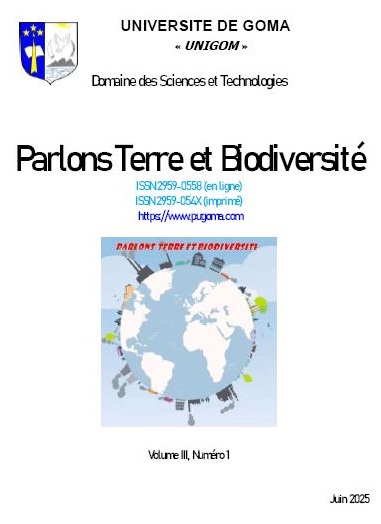Modification chimique de graphène par un complexe moléculaire de Gadolinium (Gd) : Applications en IRM et Spintronique
Contenu principal de l'article
Résumé
Résumé
Les groupes carbonyle ont été introduits sur une surface de graphène via la méthode modifiée de
Hummer. Nitrate de sodium et permanganate de potassium utilisés comme réactifs oxydants. Acide L-ascorbique
(L-AA) utilisé pour produire de l'oxyde de graphène réduit (rGO). Une concentration plus faible de groupe carboxylique
sur l'oxyde de graphène réduit a influencé les propriétés magnétiques et électroniques de l'échantillon.
L'environnement magnétique affecte les propriétés de transport électronique de l'oxyde de graphène et oxyde de
graphène réduit. La présence de groupes carbonyle a été caractérisée par spectroscopie infrarouge à transformée de
Fourier (FT-IR) et spectroscopie Raman. La quantification du groupement de fonctionnalisation a été déterminée
par titrage Boehm. Les résultats indiquent des comportements paramagnétiques de l’échantillon. La concentration
du groupe fonctionnel organique (carbonyle) augmente la pente de la courbe hystérique liée à la concentration en
Gd dans le matériau. Il est démontré qu'une modification de surface élevée de l'oxyde de graphène et de l'oxyde de
graphène réduit à l'aide de Gd-DTPA augmente l'excitation de l'électron de gadolinium dans sa dernière orbitale.
Ces complexes peuvent être utilisés pour augmenter ou diminuer les temps de relaxation des noyaux de carbone 13
en spectrométrie RMN.
Abstract
Carbonyl groups were introduced onto a graphene surface using the modified Hummer method. Sodium
nitrate and potassium permanganate used as oxidizing reagents. L-ascorbic acid (L-AA) used to produce reduced
graphene oxide (rGO). A lower concentration of carboxyl group on the reduced graphene oxide influenced the
magnetic and electronic properties of the sample. The magnetic environment affects the electronic transport
properties of graphene oxide and reduced graphene oxide. The presence of carbonyl groups was characterized by
Fourier transform infrared spectroscopy (FT-IR) and Raman spectroscopy. Quantification of the functionalizing
group was determined by Boehm titration. The results indicate paramagnetic behavior of the sample.
Con-centration of the organic functional group (carbonyl) increases the slope of the hysterical curve linked to Gd
con-centration in the material. High surface modification of graphene oxide and reduced graphene oxide with
Gd-DTPA has been shown to increase the excitation of the gadolinium electron in its last orbital. These complexes
can be used to increase or decrease the relaxation times of carbon-13 nuclei in NMR spectrometry.
Details de l'article

Ce travail est disponible sous la licence Creative Commons Attribution 4.0 International .
